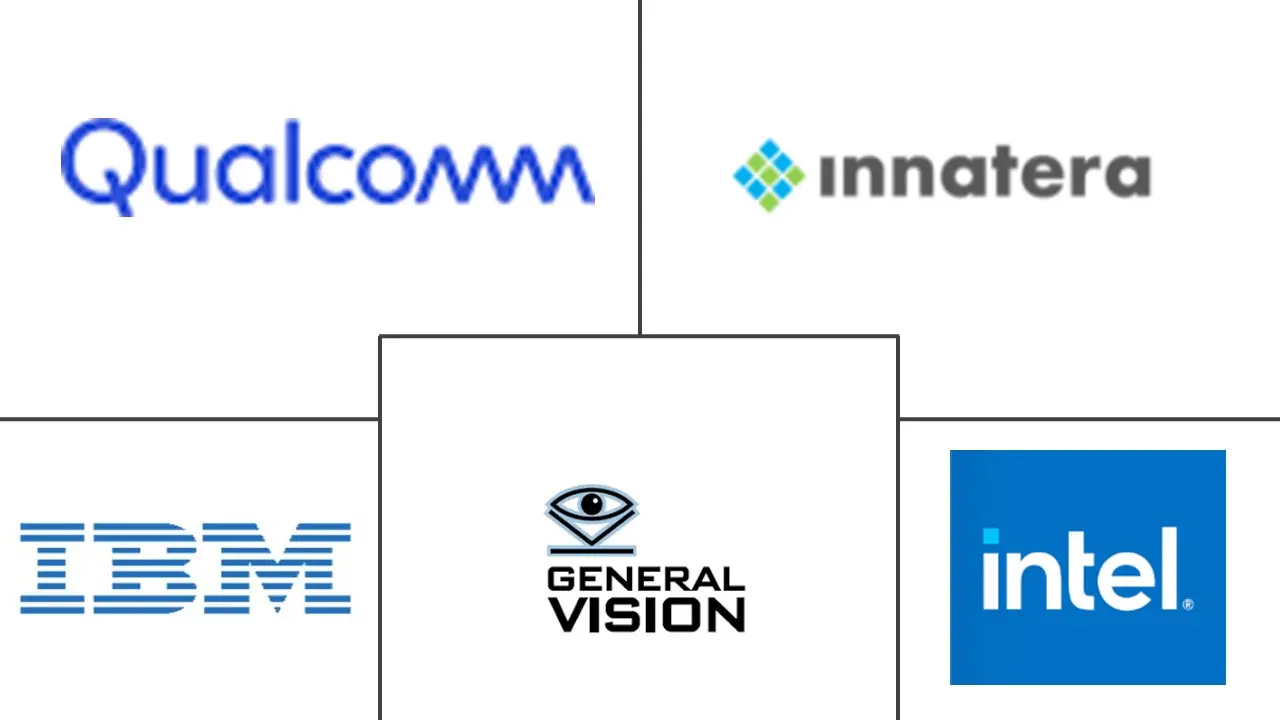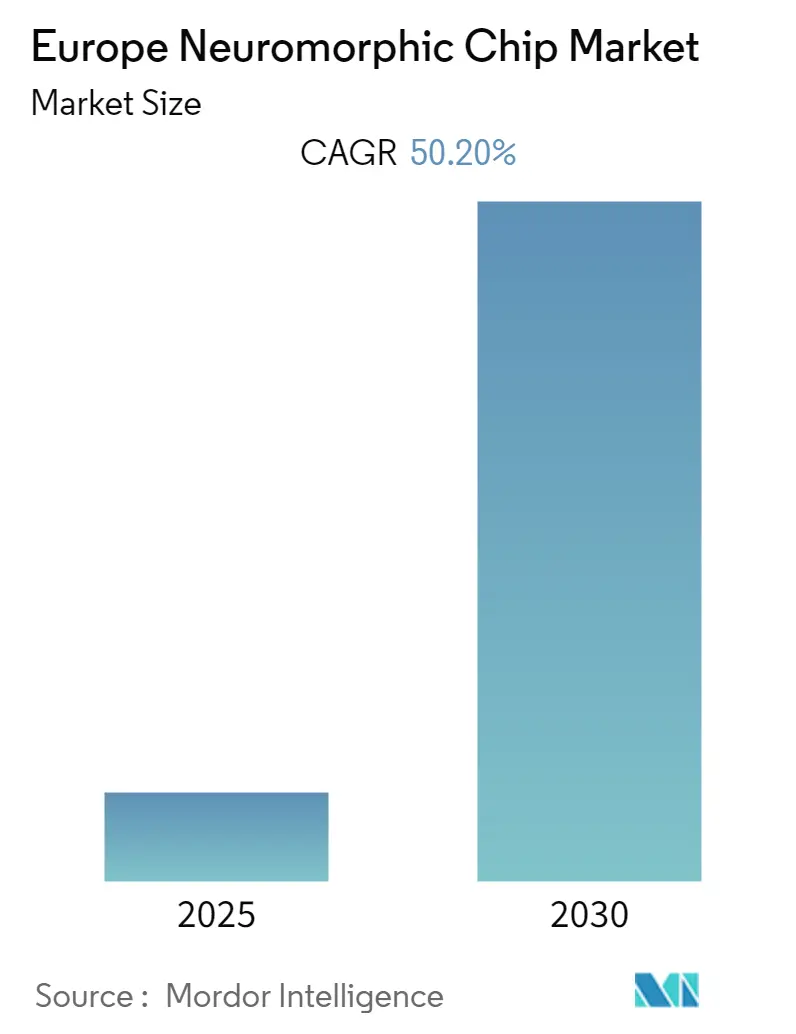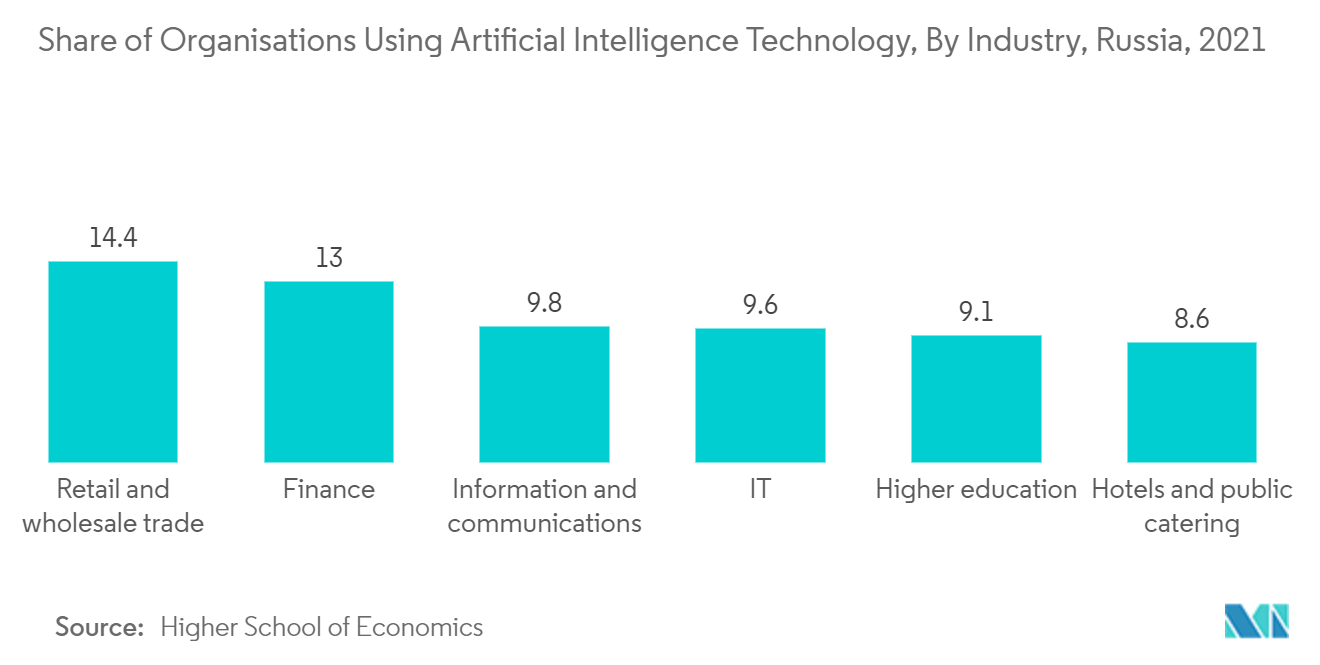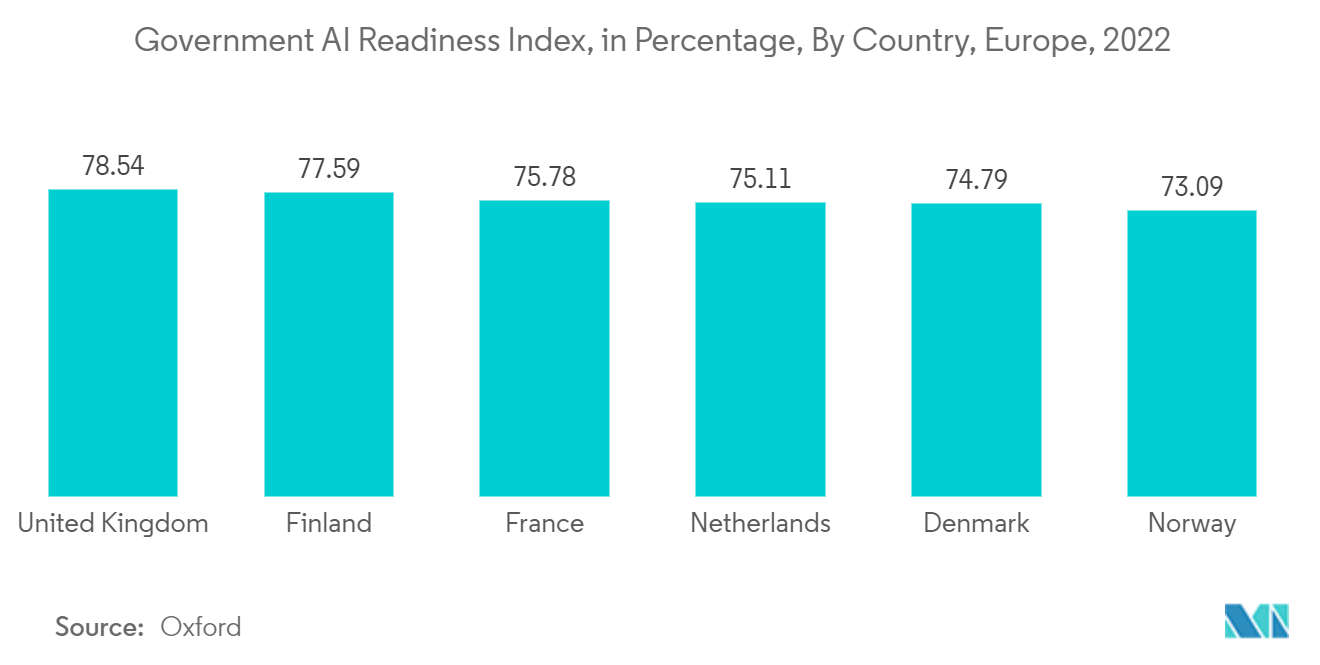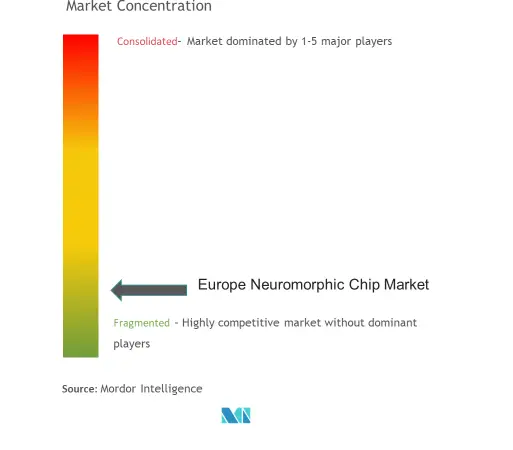Europe Neuromorphic Chip Market Analysis
The Europe Neuromorphic Chip Market is expected to register a CAGR of 50.2% during the forecast period.
- With the appearance of intelligent technology, smart sensors are getting used in many end-consumer industries like automotive, electronics, and medical. The increase of the neuromorphic chip marketplace is hindered because of the gradual tempo of development, notwithstanding heavy R&D investments and rising complexities of hardware design.
- Implementing neuromorphic chips throughout extensive end-customers, including medical, navy, protection, etc., is possible in this region. Current deep-mastering strategies and related hardware face numerous hurdles, including the economics of Moore's Law, which makes it appreciably hard for a start to compete withinside the AI space, restricting competition.
- Meanwhile, the market needs extra real-time speech popularity and translation performance, real-time video understanding, and real-time view for robots and cars. Several programs require additional intelligence that mixes sensing and computing.
- Moreover, the increasing use of biometrics and in-speech recognition drives the demand for neuromorphic chips in smartphones. These chips are used to process audio data in the cloud and then return it to the phone. Additionally, Artificial Intelligence (AI) requires more computing power. Still, low-energy neuromorphic computing could significantly push applications presently in the cloud to run directly in the smartphone in the future without substantially draining the phone battery.
- The prominent features driving the adoption of neuromorphic chipsets include low power consumption, stochastic operations, pattern recognition, fault tolerance, faster computation, and scalability. Emulating neurons on a chip should improve processes and make business decisions cost-effective and reliable.
- The outbreak of COVID-19 has created unprecedented circumstances resulting in many deaths and risk of community spreading throughout the world. This created a need for desperate measures to detect the disease at an early stage via various medically proven methods like chest computed tomography (CT) scan, chest X-Ray, etc., to prevent the virus from spreading across the community. Developing deep learning models for analyzing these radiological images is a well-known methodology in computer-based medical image analysis. Further, the market has gained traction as the countries are removing restrictions and things are returning to normal. The demand for neuromorphic chips is anticipated to grow significantly over the forecasted period.
Europe Neuromorphic Chip Market Trends
AI-based Chips are Expected to Drive the Market Growth
- Artificial Intelligence (AI) is witnessing significant corporate investment, and the chips market is receiving increasing interest and attention. End-users have already adopted many applications, and numerous emerging applications are expected to happen in the short term.
- AI accelerators are leading the region because of the computing limitations of CPUs. Available AI accelerators are GPUs, Application-Specific Integrated Circuits (ASICs), and Field-Programmable Gate Arrays (FPGAs). GPUs have many parallel processing cores, which gives them a significant advantage for processing AI training and inference.
- Neuromorphic chips are poised to be the prominent option concerning parallelism, energy efficiency, and performance. They can handle both AI inference and training in real time. Moreover, edge training is possible through neuromorphic chips. However, learning methodologies should improve their accuracy.
- Neuromorphic hardware is transferring out of the studies lab with a convergence of pursuits and desires from the sensing, computing, and reminiscence fields. Joint ventures are being formed, and decade-length investigation tasks, including the European Union's Human Brain, are being launched.
- Neuromorphic recognition and computation can solve many of AI's current problems while opening up new applications for decades. With an ecosystem of research and innovation, Europe is well-positioned to advance a culture of science and capitalize on technological opportunities.
United Kingdom to record growth in Neuromorphic Chips
- The European region, mainly the United Kingdom, is also expected to witness growth in neuromorphic chips due to government projects, investments from vendors, etc. Several long-term research projects are attracting collaborations for advancements in neuromorphic technology. Also, Italy, Germany, France, Portugal, and other countries are focusing on improving the growth of neuromorphic chips in various business areas.
- Also, the NeurONN research project funded by H2020's EU research and innovation program with a core subject, "Energy-efficient bio-inspired devices accelerate the route to brain-like computing," brought together some prominent European research and academic institutions. The project is planned for 36 months (January 2020 - December 2022).
- Local vendors in the region also focus on developing neuromorphic chips through funding from various venture capitalists in the market. Such investments are expected to shape the market in terms of innovation.
- Further, the United Kingdom's Advanced Processor Technologies Group at the University of Manchester runs on a low-grade supercomputer called SpiNNaker. It stands for Spiking Neural Network Architecture. It is assumed to stimulate so-called cortical microcircuits, subsequently the human mind cortex, and assist us in recognizing complicated illnesses like Alzheimer's.
- A study by Chip AI and Strathclyde University in the United Kingdom found that the ability to process large amounts of data in today's data-driven world is critical. Critical tasks such as pattern recognition and image classification are well suited for artificial neural networks (ANN). They are inspired by neuromorphic computing approaches that target the physical implementation of brains and ANNs.
Europe Neuromorphic Chip Industry Overview
The Europe neuromorphic Chip Market is moderately fragmented, with key players such as Brain Corporation, Intel Corporation, Qualcomm, IBM Corporation, General Vision Inc., Lockheed Martin Corporation, Innatera Nanosystems BV, and more. These companies are investing and innovating new products to expand the market in various applications.
- April 2022 - BrainChipHoldings Ltd and nViso SA announced a collaboration to address the need for high levels of AI performance with ultra-low power technologies in robotics and mobility/automotive. The first step will be implementing NVISO's AI solutions for Social Robots and In-cabin Monitoring Systems on BrainChip's AkidaTMprocessors.
- March 2022 - Brainchip, a company involved in the commercial production of ultra-low power neuromorphic AI chips and IP, announced that it has SalesLink, a European technology solutions provider, to optimize local market sales throughout the region to expand the commercial reach of its Akidaneuromorphic computing platform.
Europe Neuromorphic Chip Market Leaders
-
Intel Corporation
-
IBM Corporation
-
Innatera Nanosystems B.V.
-
General Vision, Inc
-
Qualcomm Technologies, Inc.
- *Disclaimer: Major Players sorted in no particular order
Europe Neuromorphic Chip Market News
- September 2022 - Prophesee, a company involved in neuromorphic vision systems, closed a EUR 50 million C Series round with new investment from Prosperity7 to drive the commercialization of revolutionary neuromorphic vision technology; it has become the EU's most well-funded fabless semiconductor startup.
- March 2022 - a research team from the Technical University of Kaiserslautern of Germany was awarded a $ 1.5 million ERC Starting Grant by the European Research Council (ERC) for the next five years to develop neuromorphic computer technology. Such continuous government aid to support neuromorphic technology from government bodies is expected to aid the growth of the neuromorphic chip market in Europe.
Europe Neuromorphic Chip Industry Segmentation
Neuromorphic chips are digitally-processed analog chips with a series of networks similar to human brain networks. These chips contain millions of neurons and synapses to augment self-intelligence, irrespective of pre-installed codes in normal chips. As a special kind of chip, these are highly capable of manipulating data received through sensors.
The market studied tracks Deep Learning Hardware and Neuromorphic chips as separate markets. The market study gives detailed information on the market segments, such as by application and end-user markets. Also, an analysis of the impact of COVID-19 on the Neuromorphic Chip Industry is made part of the study. The market sizes and forecasts are provided in terms of value (USD million) for all the above segments.
| Application | Image Recognition |
| Signal Processing | |
| Data Processing | |
| Others | |
| End-User | Aerospace and Defence |
| Automotive and Transportation | |
| Industrial Automation | |
| Health Care | |
| Consumer Industry | |
| Others | |
| Country | United Kingdom |
| Germany | |
| France | |
| Rest of Europe |
Europe Neuromorphic Chip Market Research FAQs
What is the current Europe Neuromorphic Chip Market size?
The Europe Neuromorphic Chip Market is projected to register a CAGR of 50.2% during the forecast period (2025-2030)
Who are the key players in Europe Neuromorphic Chip Market?
Intel Corporation, IBM Corporation, Innatera Nanosystems B.V., General Vision, Inc and Qualcomm Technologies, Inc. are the major companies operating in the Europe Neuromorphic Chip Market.
What years does this Europe Neuromorphic Chip Market cover?
The report covers the Europe Neuromorphic Chip Market historical market size for years: 2019, 2020, 2021, 2022, 2023 and 2024. The report also forecasts the Europe Neuromorphic Chip Market size for years: 2025, 2026, 2027, 2028, 2029 and 2030.
Our Best Selling Reports
Europe Neuromorphic Chip Industry Report
Statistics for the 2025 Europe Neuromorphic Chip market share, size and revenue growth rate, created by Mordor Intelligence™ Industry Reports. Europe Neuromorphic Chip analysis includes a market forecast outlook for 2025 to 2030 and historical overview. Get a sample of this industry analysis as a free report PDF download.

